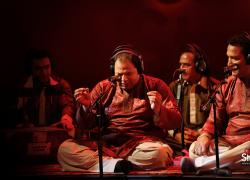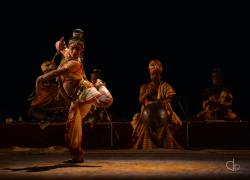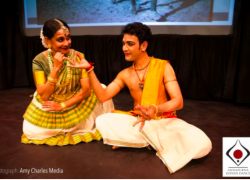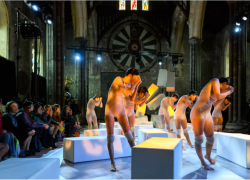Unsung Stories from the Kitchen
The Kitchen
A dance film directed by Vishwakiran Nambi
Chamudeshwari Studios, Bangalore
6 February 2021
Reviewed by Veena Basavarajaiah
The film opens with the shot of a traditional upper class South Indian kitchen. A woman enters, holding the arti (sacred light) in a tray and murmuring a chant rendering the space both sacred and private. She sits in front of the hearth, defining her role in the household. Three more women appear in the cramped kitchen dressed in traditional clothes that suggest different age groups. The space is bustling as the women alternate between doing chores like winnowing, grating, garnishing or chopping in the periphery and performing small movement sequences in the centre.
Vishwakiran Nambi’s directorial debut The Kitchen, produced by his partner Vandana Menon, premièred at Chamudeshwari Studios in Bangalore on 6th February this year. This film was created in collaboration with bharatanatyam dancers Shruthi Suresh, Namitha B Rao, Aswathy Manoharan and Maithri Rao, who bring the piece together with their presence, performance and personal stories. Nambi is an emerging choreographer from India who is carving a niche for himself designing movement for the camera. As well as directing movement for music videos he has choreographed for feature films including Kavaludaari and Mahanati.
The choreographer’s choice to use bharatanatyam to represent both the identity and role of women in the kitchen is very effective in the film. The movement form is seen distorting, breaking and adapting, much as the women who are battling with tradition try to fit into the modern world. The film establishes well a man's relationship to the kitchen with a brief but effective cameo appearance of a male character who enters the kitchen to drink a glass of water and asks the womenfolk questions about what is being served and how soon. In that fleeting moment, the women are seen responding with a sense of submission and obedience to the entitled male presence.
The blaring sound track, composed by Govind Vasantha and Adrian Rodrigues, serves as the background for the entire film, only paused during short conversations between the actors. These interspersed pieces of dialogue in Kannada (a language of South India) act as a prelude to the larger story that is later elaborated by the performers through mime and movement. The ear-splitting music explodes as the dancers move within the constraint of the space, and stories implode in silence resonating with the muffled voice of a homemaker in the drudgery of daily life.
Nambi, in his maiden effort as director, attempts to empathise and tell stories of powerful women in this dance film. This male gaze strives to portray the violence and misogyny experienced by women; what it does capture is the silencing of female voices by the oppressive noise of patriarchy.
Veena Basavarajaiah
The Kitchen will be showcased at various film festivals across the world. Those interested in watching it online can send an email to vishwa@vndc.in requesting a private link to the film.





















